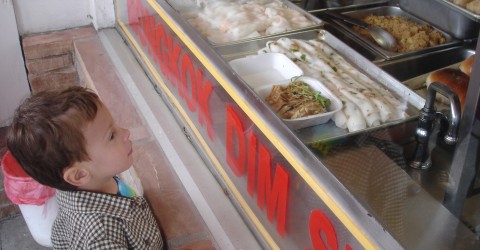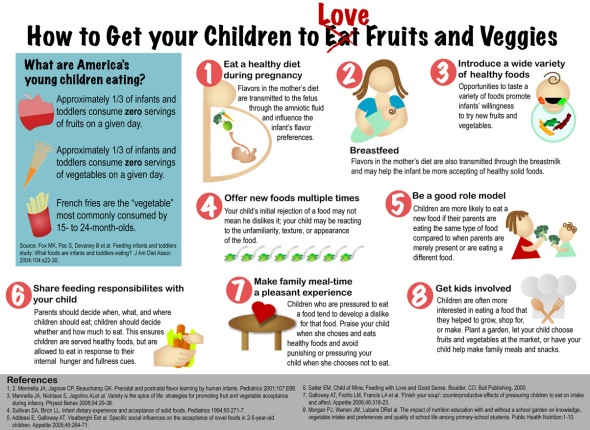Picky Eaters Part 2: The Cause (It’s All Your Fault)
Posted: September 19, 2012 Filed under: food politics, health and safety, kid food | Tags: childhood obesity, children's nutrition, food neophobia, fruit and vegetable consumption, Pediasure, picky eaters 10 CommentsParents of Picky Eaters, It’s Not Your Fault! Or so said one mother, writer, and former picky eater in a New York Times Motherlode blog this summer. I’ve been stewing over it ever since. Steaphanie V.W. Lucianovic, author of Suffering Succotash: A Picky Eater’s Quest to Understand Why We Hate the Foods We Hate, boldly stands up to the judgy mothers club–but she misses a few really critical points. I speak for all the “Mommy McJudgersons” out there when I say, parents of picky eaters–it is all your fault. Or at least it mostly is.
I came to this realization at Montessori preschool orientation night. The director began discussing lunches and I settled in, ready to hear the typical harangue about packing natural, nutritious, environmentally friendly lunches in containers the kids could open themselves. Instead he says, “Just pack what they’ll eat. Don’t try to impress us with your lunches–just pack something that won’t end up in the trash.” Then he went on to relate how one kid ate a vegetarian hotdog every day the whole year. And if that’s what it takes, we should do the same.
What? Is this what it’s come to?
Of course, I am guilty of the other extreme–I remember sending elaborate bento lunches to preschool with our first son. I was so excited and I wanted to impress his teacher. Well, he couldn’t open the containers and he didn’t know what to do with the little onigiri triangles and edamame pods. Only his teachers wouldn’t put it in the trash. He’d bring home a box of warm, greasy garbage every day. I figured out pretty quickly that I wasn’t impressing anybody. I get that you should pack something the kid can eat. But a vegetarian hot dog every day? That’s going too far.
Our generation has just thrown up our hands and given up trying to eat normally. We’ve also given up a huge responsibility we owe to our children. It’s our job to teach them how to appreciate a wide variety of healthy, well-prepared, delicious food. If we act like we can’t do a damn thing about what they eat, then where are we? I’ll tell you where we are–we’re in the midst of a nation-wide obesity epidemic affecting a generation of children who are on their way to enjoying a shorter life expectancy than their parents. Nope. We can’t just sit back and let them eat vegetarian hot dogs.
Or white bread. Or cheese pizza. Ask yourself who’s in charge of your kids’ meals. If it’s not you, then you have a problem. Blaming bad eating habits on “picky eating” is a cop out.
Sure, many toddlers (some studies say around 20%) go through a picky eating stage. And nearly all young children avoid bitter tasting foods. This is most likely evolution’s way of making sure we didn’t poison ourselves to extinction. A picky eating stage may be an evolutionary adaptation, but it’s no longer beneficial. Picky eating usually means kids aren’t eating vegetables and can even mean kids are malnourished, so it’s something parents need to address.
Letting your kid eat Pop Tarts for breakfast or chicken nuggets every night (or, God help you, vegetarian hot dogs), will just make matters worse. Read the ingredients list on the back of the packages you’re buying. If there’s more than three or four ingredients, your children probably shouldn’t be eating it–even if it has a day’s worth of vitamins inside. Take Pediasure, many well-meaning parents’ go to solution to picky eating:
Pediasure Kickstart Strawberry Flavor Ingredients:
WATER, SUGAR, MILK PROTEIN CONCENTRATE, SOY OIL, SHORT-CHAIN FRUCTOOLIGOSACCHARIDES, SOY PROTEIN ISOLATE; LESS THAN 0.5% OF: CELLULOSE GEL, WHEY PROTEIN CONCENTRATE, POTASSIUM CITRATE,POTASSIUM CHLORIDE, NATURAL AND ARTIFICIAL FLAVOR, MAGNESIUM PHOSPHATE, CALCIUM PHOSPHATE, SALT, POTASSIUM PHOSPHATE, CALCIUM CARBONATE, CELLULOSE GUM, CHOLINE CHLORIDE, ASCORBIC ACID, CARRAGEENAN, SOY LECITHIN, MONOGLYCERIDES, POTASSIUM HYDROXIDE, m-INOSITOL, TAURINE, FERROUS SULFATE, dl-ALPHA-TOCOPHERYL ACETATE, L-CARNITINE, ZINC SULFATE, CALCIUM PANTOTHENATE, NIACINAMIDE, FD&C RED #3, MANGANESE SULFATE, THIAMIN CHLORIDE HYDROCHLORIDE, PYRIDOXINE HYDROCHLORIDE, RIBOFLAVIN, CUPRIC SULFATE, VITAMIN A PALMITATE, FOLIC ACID, CHROMIUM CHLORIDE, BIOTIN, SODIUM SELENATE, POTASSIUM IODIDE, SODIUM MOLYBDATE, PHYLLOQUINONE, VITAMIN D3, AND CYANOCOBALAMIN.
I want to hear the justification for feeding this to your kid instead of food. What did parents with picky eaters do before KickStarts? Obviously, the human race didn’t starve to death. I bet not even one little kid starved to death because he was a fussy eater. Parents of generations past simply put food on the table and expected the kids to eat it. If they didn’t, parents assumed the kid would eat more at the next meal. What they didn’t do is hand them a high fructose corn syrup laden nutrition bar and call it a meal.
My mother is a biologist and my father is a psychologist, so for me everything is a dichotomy between nature and nurture. This is no different. Food preference is certainly heritable–according to one study, over 75% of food preference can be attributed to genetics. But lots of things are genetic and not necessarily desirable. Bad teeth are genetic. So are you going to let your kid walk around with a snaggletooth for the rest of his life? No. You get him braces. Genetics isn’t destiny–if you come from a bad food gene pool, do something about it.
Picky eaters may be born, but let’s pause a minute before we say they’re not made. We begin to shape our children’s eating behaviors in infancy (and even in utero). What a mother eats during breastfeeding (and wether she breastfeeds), how and when parents introduce new foods, the variety of foods introduced before age four and maternal feeding practices can all affect a child’s food preferences. Studies show that mothers’ eating habits and attitudes about food shape their children’s habits and attitudes. If you’re always on a diet, your kids take notice and if you won’t eat anything green, neither will your kids. Children are more likely to try new things if they see their parents and siblings trying new things. The reverse is also true. If you’re weird about food, your kid’s going to have issues, too. For example, mothers who are emotional eaters may be more likely to have picky children. Parents who are overly controlling can negatively affect children’s eating behavior and possibly increase their risk of obesity. Parents can exert a great deal of positive influence by simply modeling healthy eating behaviors. Clearly, what we do as parents makes a critical difference in how our children eat.
Developmental stages, evolution and genetics are beyond our control. But even if we assume we can do nothing to change our child’s genetic destiny, we can still agree that the 25% of food preference that isn’t heritable might be under our control. Let’s be conservative–say we can influence 20% or our kids’ food preferences (keeping in mind that this a ridiculously low percentage). Well, then let’s have at it! Let’s do everything we can to teach them how to eat good food. Let’s work as hard on food appreciation as we do times tables or reading.
We can’t just chalk our kids’ bad eating habits up to “picky eating.” We need to take some responsibility. Our kids’ lousy eating habits are more likely the product our lax (or over-controlling) parenting and our own bad eating habits.
Okay, I’m judging, but I’m not excluding myself from the judgment. I’m just as guilty as the next over-worked, over-scheduled, exhausted mother of three fussy, hungry kids who need to eat all the damn time. We just want them to eat something. I fed my kids macaroni and cheese (but it was organic!) and steamed broccoli every other day when I was working full time. I don’t know how it happened–I certainly didn’t plan it that way. It happens to all of us. But at some point, we have to make it a priority to feed our children well. We are missing a good opportunity to enrich our children’s lives when we don’t prioritize teaching them how to eat well. As a society and as families, we need to decide that what our kids eat is just as important as what they learn in school or what they watch on TV.
We’ve forgotten how to eat. It’s not just our fault for accepting the status quo, it’s the fault of the status quo itself. Americans don’t eat normally. French fries are the most common vegetable eaten in the United States. Our school lunch rooms sell Cheetos. We eat 20 percent of our meals in the car (and you can’t drive a mile without passing a fast food restaurant). Our grocery stores are lined with aisle upon aisle of packaged food and we are so busy and tired, we justify buying it to save time. It’s almost impossible not to make these kinds of desperate choices as parents. And it’s hard to change habits when you’re exhausted and stretched thin as it is. It feels like all you can do to get the chicken nuggets on the table.
But this isn’t something that we can’t fix if we acknowledge that our food culture is damaged and we’re partly to blame.We can examine our own attitudes about food and eating. We can reject the food system American industry (with the help of American government) has created and embrace real American food culture. There’s a bounty of fresh produce at your farmers’ market. There’s a world of ethnic cuisine to sample. There’s a spot in your back yard waiting for a garden. And there’s time to cook and eat dinner together (almost) every night. We just have to make it important enough.
Related articles
- Motherlode Blog: Parents of Picky Eaters, It’s Not Your Fault (parenting.blogs.nytimes.com)
- Another Way to Get Kids to Eat Read this one–it’s funny.
- Development of Childhood Food Preferences (savortherainbow.com)
- Picky Eating Part 1: The Cure (phoenixfoodfighters.com)


